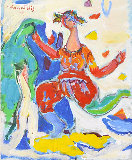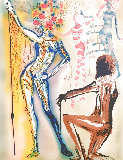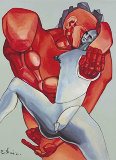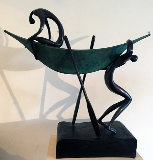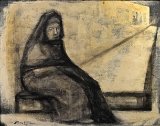






Fables of Fontaine: the Fisherman and the Small Fish 1927
Marc Chagall
Limited Edition Print : Etching on Montval Paper
Size : 11.5x9.5 in | 29x24 cm
Framed : 17x15 in | 43x38 cm
Edition : From the Edition of 200
Reduced
- 🔥1927 Framed Limited Edition Etching $3,700
Year1927
Plate SignedLower Right
Condition Excellent
Framed with PlexiglassBlack Frame w/ White Mat
Purchased fromAuction House 2022
Story / Additional InfoIn 1927, Chagall began working on a print project for Ambrose Vollard, a series of etchings illustrating The Fables of La Fontaine. With these plates Chagall moved from the fantastic Russia of Chagall’s imagination and memory to the more dream-like world of ancient myth and fable, In the fable illustrated in this print, a fisherman catches a small fish. The fish asks the fisherman to release it in the hope that the fish will grow and when caught again would be worthy of a more satisfying meal. The fisherman replies "How foolish I should be,to throw you back. However small you may be, you are better than nothing at all." The moral of this particular fable is that a small gain is worth more than a large promise.
Certificate of AuthenticityArt Brokerage
LID157065
Marc Chagall - Russian Federation
Art Brokerage: Park West: Marc Chagall French-Russian Artist: Marc Chagall was a French-Russian artist whose work anticipated the dream-like imagery of Surrealism. Over the course of his career Chagall developed the poetic, amorphous, and deeply personal visual language evident in the painting I and the Village (1911). "When I am finishing a picture, I hold some God-made object up to it—a rock, a flower, the branch of a tree or my hand as a final test," he said. "If the painting stands up beside a thing man cannot make, the painting is authentic. If there's a clash between the two, it's bad art." Born Moishe Shagal on July 7, 1887 in Vitebsk, Russia (present-day Belarus) to a Hasidic Jewish family, the artist was raised immersed in Jewish culture and iconography. Studying under the artist Yehuda Pen as a youth, the Judaic traditions and folklore of his hometown permeated Chagall's paintings. After studying in St. Petersburg, the artist moved to Paris in 1910, where he quickly befriended members of the French avant-garde, including Robert Delaunay and Fernand Léger. Visiting Russia in 1914, the artist was prevented from returning to Paris due to the outbreak of World War I until 1926. In addition to his paintings, Chagall was also noted for his vibrant works in stained glass and lithography. Forced to flee Paris during World War II, Chagall lived in the United States and traveled through to Israel before returning to France in 1948. The artist died in Saint-Paul-de-Vence, France on March 28, 1985. Today, his works are held in the collections of The Museum of Modern Art in New York, the Tate Gallery in London, the Tel Aviv Museum of Art, and the Albertina in Vienna, among others. Listings wanted.



























